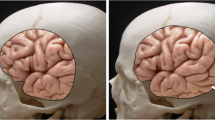Abstract
To determine one-year clinical outcome of patients with first-ever acute ischemic stroke involving the territory of paramedian mesencephalic arteries (PMAS), we conducted a prospective study evaluating the cognitive functions of 28 patients with PMAS. Neuropsychological tests were performed during the first month of stroke onset and at the 12th month of follow-up. There were 12 women and 16 men. Mean age of onset for women and men was 70 years and 65 years, respectively. Progressing strokes occurred in 62% of patients and 96% developed a full-blown picture of the clinical triad of akinetic mutism, hypersomnolence, and bilateral blepharoptosis and ophthalmoparesis. Involuntary movements occurred in 6, and focal myoclonus in 4 patients. The top four associated risk factors were hypertension (68%), hyperlipidemia (57%), diabetes mellitus (46%), and atrial fibrillation (36%). Unilateral midbrain infarctions occurred in 12 patients and bilateral lesions in 16. Thalamic infarctions were unilateral in 10 and bilateral in 13 cases. Three of the 28 (11%) patients died of recurrent cerebral infarctions within 1 year of the onset of PMAS. The recurrent infarctions involved the basilar artery territory in two cases and the carotid system in another. One patient died of acute myocardial infarction. Of the 24 patients who had survived the stroke by 1 year, 20 (71%) developed dementia. We conclude that first-ever ischemic stroke with PMAS is not a benign syndrome. Most patients developed dementia by 1 year after the stroke.
Similar content being viewed by others
References
L.R. Caplan: “Top of the basilar syndrome”, Neurology, Vol. 30, (1980), pp. 72–79.
J.M. Segarra: “Cerebral vascular disease and behavior: I. The syndrome of the mesencephalic artery (basilar artery bifurcation)”, Arch. Neurol., Vol. 22, (1970), pp. 408–418.
M.S. Hochman, J.J. Sowers and J. Bruce-Gregorios: “Syndrome of the mesencephalic artery: report of a case with CT and necropsy findings”, J. Neurol. Neurosurg. Psychiatry, Vol. 48, (1985), pp. 1179–1181.
G. Sieben, J. De Reuck and H.V. Eecken: “Thrombosis of the mesencephalic artery: A clinico-pathological study of two cases and its correlation with the arterial vascularisation”, Acta Neurol. Belg., Vol. 77, (1977), pp. 151–162.
J. Bogousslavsky and F. Regli: “Intra-axial involvement of the common oculomotor nerve in mesencephalic infarctions”, Rev. Neurol., Vol. 140, (1984), pp. 263–270.
J. Biller, R. Shapiro, L.S. Evans, J.R. Haag and M. Fine M: “Oculomotor nuclear complex infarction: Clinical and radiological correlation”, Arch. Neurol., Vol. 41, (1984), pp. 985–987.
J.H. Growdon, G.F. Winkler and S.H. Wray: “Midbrain ptosis: A case with clinico-pathological correlation”, Arch. Neurol., Vol. 30, (1974), pp. 179–181.
P. Castaigne, F. Lhermitte, A. Buge, R. Escourolle, J.J. Hauw and O. Lyon-Caen: “Paramedian thalamic and midbrain infarcts: clinical and neuropathological study”, Ann. Neurol., Vol. 10, (1981), pp. 127–148.
G. Percheron: “Arteries of the human thalamus: II. Arteries and paramedian thalamic territory of the communicating basilar artery”, Rev. Neurol., Vol. 132, (1976), pp. 309–324.
T. Hashimoto, F. Tamaru, T. Mitsui, K. Satake and N. Yanagisawa: “A case of mid-brain and thalamic infarction showing Collier’s sign in one side and blepharoptosis in the other side”, Clin. Neurol., Vol. 31, (1991), pp. 636–640.
M.F. Folstein, S.E. Folstein and P.R. McHugh: “Mini-Mental State: a practical method for grading the cognitive state of patients for the clinicians”, J. Psychiatr. Res., Vol. 12, (1975), pp. 189–198.
P. Thajeb, T. Thajeb and D.F. Dai: “Cross-cultural studies using the modified mini mental test for healthy subjects and patients with various forms of vascular dementia”, J. Clin. Neurosci., (2006) (Epub ahead of print in press).
E. Carrera, P. Michel and J. Bogousslavsky: “Anteromedian, central, and posterolateral infarcts of the thalamus: three variant types”, Stroke, Vol. 35(12), (2004), pp. 2826–2831.
E. Carrera, and J. Bogousslavsky: “The thalamus and behavior: effects of anatomically distinct strokes”, Neurology, Vol. 66, (2006), pp. 1817–1823.
C.M. Fisher: “Lacunar strokes and infarcts: a review”, Neurology, Vol. 32, (1982), pp. 871–876.
M.G. Matheus and M. Castillo: “Imaging of acute bilateral paramedian thalamic and mesencephalic infarcts”, Am. J. Neuroradiol., Vol. 24, (2003), pp. 2005–2008.
I. Derakhshan, M. Sabouri-Deylami and B. Kaufman: “Bilateral Nothnagel syndrome: Clinical and roentgenological observations”, Stroke, Vol. 11, (1980), pp. 177–179.
J. Poirier, J. Barbizet, A. Gaston and C. Meyrignac: “Thalamic dementia: Expansive lacunae of the thalamo-paramedian mesencephalic area. Hydrocephalus caused by stenosis of the aqueduct of Sylvius”, Rev. Neurol., Vol. 139, (1983), pp. 349–358.
S. Gulyas, F. Nagy and I. Szirmai: “Complex eye movement disturbance in thalamic and mesencephalic infarcts”, Ideggyogy. Sz/Clin. Neurosci., Vol. 59(5–6), (2006), pp. 193–200.
I. Ameridou, M. Spilioti and G. Amoiridis: “Bithalamic infarcts: embolism of the top of basilar artery or deep cerebral venous thrombosis?”, Clin. Neurol. Neurosurg., Vol. 106, (2004), pp. 345–347.
M. Milisavljevic, S. Marinkovic, V. Lolic-Draganic and M. Kovacevic: “Oculomotor, trochlear, and abducens nerves penetrated by cerebral vessels: Microanatomy and possible clinical significance”, Arch. Neurol., Vol. 43, (1986), pp. 58–61.
A. Arboix, M. Lopez-Grau, C. Casasnovas, L. Garcia-Eroles, J. Massons and M. Balcells: “Clinical study of 39 patients with atypical lacunar syndrome”, J. Neurol. Neurosurg. Psychiatry, Vol. 77, (2006), pp. 381–384.
M.P. Alexander: “Chronic akinetic mutism after mesencephalic-diencephalic infarction: remediated with dopaminergic medications”, Neurorehab. Neural. Repair, Vol. 15, (2001), pp. 151–156.
Author information
Authors and Affiliations
About this article
Cite this article
Thajeb, P., Thajeb, T. & Dai, DF. Clinical analysis of first-ever acute ischemic stroke involving the territory of paramedian mesencephalic arteries. cent.eur.j.med 2, 37–46 (2007). https://doi.org/10.2478/s11536-007-0001-y
Received:
Accepted:
Issue Date:
DOI: https://doi.org/10.2478/s11536-007-0001-y




